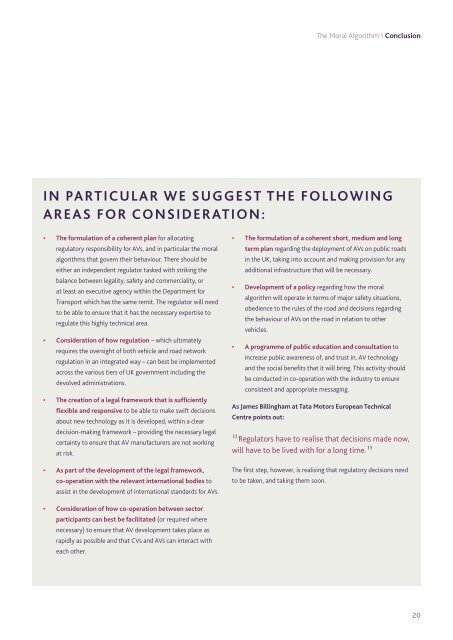THE MORAL ALGORITHM
161205-the_moral_algorithm
161205-the_moral_algorithm
You also want an ePaper? Increase the reach of your titles
YUMPU automatically turns print PDFs into web optimized ePapers that Google loves.
The Moral Algorithm \ Conclusion<br />
IN PARTICULAR WE SUGGEST <strong>THE</strong> FOLLOWING<br />
AREAS FOR CONSIDERATION:<br />
• The formulation of a coherent plan for allocating<br />
regulatory responsibility for AVs, and in particular the moral<br />
algorithms that govern their behaviour. There should be<br />
either an independent regulator tasked with striking the<br />
balance between legality, safety and commerciality, or<br />
at least an executive agency within the Department for<br />
Transport which has the same remit. The regulator will need<br />
to be able to ensure that it has the necessary expertise to<br />
regulate this highly technical area.<br />
• Consideration of how regulation – which ultimately<br />
requires the oversight of both vehicle and road network<br />
regulation in an integrated way – can best be implemented<br />
across the various tiers of UK government including the<br />
devolved administrations.<br />
• The creation of a legal framework that is sufficiently<br />
flexible and responsive to be able to make swift decisions<br />
about new technology as it is developed, within a clear<br />
decision-making framework – providing the necessary legal<br />
certainty to ensure that AV manufacturers are not working<br />
at risk.<br />
• As part of the development of the legal framework,<br />
co‐operation with the relevant international bodies to<br />
assist in the development of international standards for AVs.<br />
• The formulation of a coherent short, medium and long<br />
term plan regarding the deployment of AVs on public roads<br />
in the UK, taking into account and making provision for any<br />
additional infrastructure that will be necessary.<br />
• Development of a policy regarding how the moral<br />
algorithm will operate in terms of major safety situations,<br />
obedience to the rules of the road and decisions regarding<br />
the behaviour of AVs on the road in relation to other<br />
vehicles.<br />
• A programme of public education and consultation to<br />
increase public awareness of, and trust in, AV technology<br />
and the social benefits that it will bring. This activity should<br />
be conducted in co-operation with the industry to ensure<br />
consistent and appropriate messaging.<br />
As James Billingham at Tata Motors European Technical<br />
Centre points out:<br />
Regulators have to realise that decisions made now,<br />
“<br />
will have to be lived with for a long time.<br />
”<br />
The first step, however, is realising that regulatory decisions need<br />
to be taken, and taking them soon.<br />
• Consideration of how co-operation between sector<br />
participants can best be facilitated (or required where<br />
necessary) to ensure that AV development takes place as<br />
rapidly as possible and that CVs and AVs can interact with<br />
each other.<br />
20


